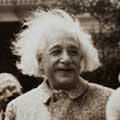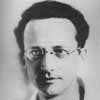
The Wave Structure Matter (WSM) model is an emerging theory in the category of metaphysics. It was proposed 150 years ago by mathematician William Kingdon Clifford and later by Erwin Schrodinger. They proposed the view that what we observe as large-scale matter (discrete and particle-like), is only the 'appearance' (schaumkommen) of wave structures in space. Since 1985, Milo Wolff and others have found a mathematical basis of Wave Structures. The theory is based upon a wave medium in all space of the universe that has the dimension of energy/volume. Though the theory is gaining popularity, it still remains largely in the domain of Fringe science possibly because the popularity is more among non-scientists than among scientists.(In what follows, the claims of the theory are given in an assertive form, without the words 'According to WSM' preceding them. These are not to be confused with currently established scientific claims.)
Two principles describe the properties of the space medium, and are the origin of all matter and the natural laws: matter determines the properties of space, and reciprocally, space determines the properties of matter. This mechanism occurs because the Wave Structure of Matter agrees with Einstein's theory of General Relativity, there are no discrete separate particles, matter is a structure of space, and thus affects the properties of space. Einstein writes:

The particle of the WSM is a spherical standing wave with an intensity, decreasing with distance from the wave center. This wave has the character of a quantum wave. The particle is regarded as the entire wave structure but its location is the quantum wave-center when observed. This fundamental structure, with presence throughout the universe, is an electron or a positron (which have opposite phase waves).
The two important basic principles of the WSM are:
Instead of interpreting a wave function as a probability distribution of discrete particles as in QM, the 'particle' is represented by the entire wave function and we locate it experimentally at the wave-center where energy-exchange takes place. Thus discrete 'particles', or charge substances, or mass substances do not exist.
(Summarized by Nicholas Cooper)
The idea, conceived over 150 years ago by William Kingdon Clifford who has become the father of the algebra of geometry ,was stated by him:
'I hold that:
(This statement also became the basis of the curvature of space that was mathematically constructed by Albert Einstein.)
In the classic view of quantum mechanics, electrons are regarded as discrete particles that can only be located within a statistically determined volume. This view uses one of two possible interpretations of the Schrodinger Equation: that (1) discrete particles do exist and waves are only 'probabilities'. Schrodinger himself took the opposite view (2) that only waves exist, whereas particles do not. His view has led to the Wave Structure of Matter.

In 1945, John Archibald Wheeler and Richard Feynman attempted to find the energy transfer mechanism of the electron - typically light. They found a 'response of the Universe' to electron outward charge waves that simulated spherical in-ward waves. However, they worked with spherical vector electromagnetic waves and retained the concept of the 'particle' which generated these waves that acted on other 'particles'. Their use of continuous vector electromagnetic waves causes problems of an infinite field strength (as radius of field tends to zero) and renormalisation. As Paul Dirac and Richard Feynman wrote;
'I must say that I am very dissatisfied with the situation, because this so called good theory does involve neglecting infinities which appear in its equations, neglecting them in an arbitrary way. This is just not sensible mathematics. Sensible mathematics involves neglecting a quantity when it turns out to be small - not neglecting it just because it is infinitely great and you do not want it!' (Paul Dirac)
'But no matter how clever the word, it is what I call a dippy process! Having to resort to such hocus pocus has prevented us from proving that the theory of quantum electrodynamics is mathematically self consistent. ... I suspect that renormalisation is not mathematically legitimate.' (Richard Feynman, The Strange Theory of Light and Matter, 1985)
Albert Einstein was also aware of this problem as he explains in his critique of Lorentz's electromagnetic field theory for electrons (as it is still the same fundamental problem of the particle / electromagnetic field duality).
'The inadequacy of this point of view manifested itself in the necessity of assuming finite dimensions for the particles in order to prevent the electromagnetic field existing at their surfaces from becoming infinitely large.' (Albert Einstein, 1936)
During this same time, Albert Einstein was working on a generalized theory of gravitation to unite the fundamental forces of nature. In his theory, he represented the electron as continuous spherical fields in space-time. His death in 1955 left his attempts at a unified field theory of matter unsolved. As Einstein writes;
'All these fifty years of conscious brooding have brought me no nearer to the answer to the question, 'What are light quanta?' Nowadays every Tom, Dick and Harry thinks he knows it, but he is mistaken. ... I consider it quite possible that physics cannot be based on the field concept, i.e., on continuous structures. In that case, nothing remains of my entire castle in the air, gravitation theory included, [and of] the rest of modern physics.' (Albert Einstein, Letter to Michael Besso, 1954)
'Einstein thinks he has a continuous field theory that avoids 'spooky action at a distance', but the calculation difficulties are very great. He is quite convinced that some day a theory that does not depend on probabilities will be found.' (Max Born, p158 Mar 1947)
The Wave Structure of Matter (WSM) simplifies Einstein's foundations, from his continuous spherical fields in space-time, to spherical waves in continuous space. By rejecting both continuous fields and particles, and instead working with standing wave structures, the WSM explains the discrete energy states of light and matter found in Quantum Theory (which Einstein's Relativity could never explain) without introducing the disturbing particle / wave duality of light and matter. As Einstein writes;
'The great stumbling block for the field theory lies in the conception of the atomic structure of matter and energy. For the theory is fundamentally non-atomic in so far as it operates exclusively with continuous functions of space, in contrast to classical mechanics whose most important element, the material point, in itself does justice to the atomic structure of matter.' (Albert Einstein, 1954)
'The special and general theories of relativity, which, though based entirely on ideas connected with the field-theory, have so far been unable to avoid the independent introduction of material points, ' the continuous field thus appeared side by side with the material point as the representative of physical reality. This dualism remains even today disturbing as it must be to every orderly mind.' (Albert Einstein, 1954)
'The Maxwell equations in their original form do not, however, allow such a description of particles, because their corresponding solutions contain a singularity. Theoretical physicists have tried for a long time (1936), therefore, to reach the goal by a modification of Maxwell's equations. These attempts have, however, not been crowned with success. What appears certain to me, however, is that, in the foundations of any consistent field theory the particle concept must not appear in addition to the field concept. The whole theory must by based solely on partial differential equations and their singularity-free solutions.' (Albert Einstein, 1954)
1.William Clifford, 1885, The Common Sense of the Exact Sciences, Ed. Karl Pearson, preface by Bertrand Russell, Dover, NY (1955).
2. E. Schrodinger. In Schrodinger - Life and Thought, Cambridge U. Press, p327 (1989).
4. E. Mach, (1883 German). English: The Science of Mechanics, Open Court (1960).
5. M. Wolff, 'Exploring the Physics of the Unknown Universe', Technotran Press, (1990).
6. M. Wolff, 'Gravitation and Cosmology' in From the Hubble Radius to the Planck Scale, R. L. Amoroso et al (Eds.), pp 517-524, Kluwer Acad. Publ. (2002).
7. W. Clifford, (1876) 'On the Space Theory of Matter' in The World of Mathematics, p568, Simon and Schuster, NY (1956).
8. J. A. Wheeler, and R. Feynman, Rev. Mod. Phys. 17, 157 (1945).
9. H. Tetrode, Zeits. F. Physik 10, 312 ((1922).
10. A. Einstein, Relativity, Crown Books (1950).
11. M. Wolff, Physics Essays 6, No 2, 181-203 (1993).
12. G. Haselhurst, (to be published in) What is the Electron, Apeiron Press (2005).
13. C. Mead, 'Collective Electrodynamics', MIT Press (2000).
14. E. Batty-Pratt and T. Racey, Int. J. Theor. Phys. 19, 437 (1980).